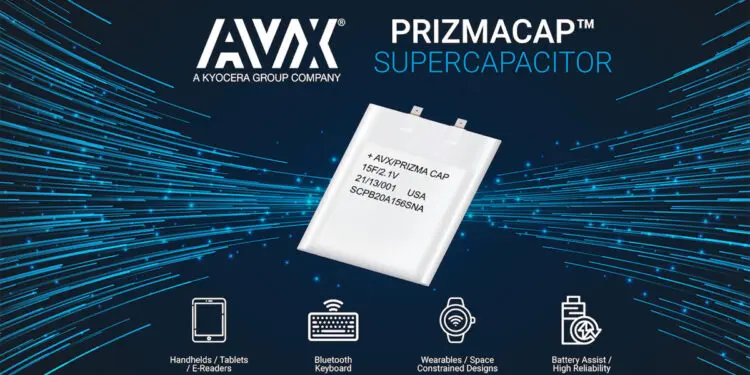Ideal for an array of SWaP-optimized, battery-powered products, the new SCP Series PrizmaCap supercapacitors have the widest operating temperature range of any available supercapacitor technology, the highest capacitance and energy density of any SFF, prismatic, EDLC >1F, and an extremely lightweight and ultralow-profile package.
AVX Corporation, a leading manufacturer and supplier of advanced electronic components and interconnect, sensor, control, and antenna solutions, has launched a superlative new series of standard and custom supercapacitors engineered to provide peak performance in an array of SWaP-optimized, battery-powered products.
The new SCP Series PrizmaCap™ supercapacitors features
- the widest operating temperature range of any supercapacitor technology currently available on the market (-55°C to +90°C)
- the highest capacitance (3.5–15F) and energy density (1.14–2.43Wh/kg) of any small form factor (SFF)
- prismatic, electric double-layer capacitor (EDLC) rated for more than 1F currently available on the market
- extremely lightweight (<2g)
- low-profile form factor (0.8–2mm)
- based on propylene carbonate electrolyte technology, which has been proven safe and effective in energy storage applications including lithium-ion batteries.
AVX’s new SCP Series PrizmaCap supercapacitors can be used alone or in conjunction with primary or secondary batteries to extend backup time, improve battery life, and provide instantaneous power pulses in energy storage, energy and power holdup, pulse power handling, and battery assist applications within a range of consumer, commercial, and industrial electronics that prioritize size, weight, and power (SWaP) optimization.
The series is especially well suited for use in end products including wearable and handheld devices, industrial equipment, wireless keyboards, power peripherals, tablets, and e-readers. SCP Series PrizmaCap supercapacitors are currently available in three standard form factors with a 48x45mm footprint, one of three ultralow height profiles: 0.8mm, 1.3mm, or 2.0mm, and two fixed-position, surface-mount terminals compatible with hand soldering or — for more reliable connections — AVX Interconnect’s economical and ultralow-profile 70-9159 Series STRIPT™ two-piece, single contacts.
These three standard solutions (SCPB08A355SNA, SCPB13A855SNA, and SCPB20A156SNA) are rated for up to 15F capacitance, 2.1V electrical potential from -55°C to +65°C, 8.63A peak current, and 2.43Wh/kg energy density, and have the widest operating temperature range of any supercapacitor technology currently available on the market, -55°C to +90°C, with appropriate derating to 1.1V. They are also rated for maximum DCL as low as 50μA after 72 hours of operation, maximum ESR as low as 30mΩ at 1kHz and 55mΩ at DC, and up to 2,582W/kg power density and 0.0092Wh maximum energy. Additional off-the-shelf solutions with standard footprints and capacitance values will be released as they are qualified, and custom SCP Series PrizmaCap supercapacitors are available with customer-specified footprints and capacitance values spanning 1–500F.
“Our new SCP Series PrizmaCap supercapacitors have a revolutionary new design in terms of form, fit, and function compared to other AVX supercapacitors, and they leverage this innovative design to deliver the highest capacitance and energy density of any currently available, small form factor, prismatic, EDLC supercapacitor rated for more than one Farad, as well as the widest range of rated operating temperatures — including both the highest and lowest extremes — of any supercapacitor technology currently available on the market,” said Eric DeRose, global product manager – Supercapacitors, AVX.
“The new PrizmaCaps also have an extremely lightweight and ultralow-profile package that’s compatible with both solder and interconnect termination processes for added design flexibility and ideal for use in compact consumer, commercial, and industrial electronics with densely populated PCBs and stringent SWaP demands.”
AVX’s new SCP Series PrizmaCap supercapacitors are RoHS- and REACH-compliant, lead-free compatible, and currently made in the USA. They are also fully tested for life cycle, high-temperature load life, temperature characteristics, vibration resistance, and humidity characteristics prior to being packaged and shipped in trays to ensure optimal performance. Standard lead-time for the series is currently 16 weeks.































